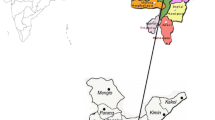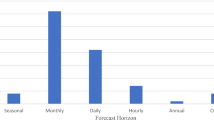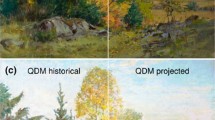Abstract
This paper, the first in a series of two, develops an entropy-based approach for evaluating rainfall networks. Space and time dependencies between raingages are examined by autocovariance and cross-covariance matrices. Multivariate distributions, associated with different dependencies, are obtained using the principle of maximum entropy (POME). Formulas for entropy (uncertainty in data of one raingage), joint entropy (uncertainty in data of two or more raingages) and transinformation (common information content among two or more raingages) are derived for each distribution, based on normal data. The decision whether to keep or eliminate a raingage depends entirely on reduction or gain of information at that raingage. The lines of equal information (isoinformation contours) are defined by considering two raingages (bivariate case) and many raingages (multivariate case).
Similar content being viewed by others
References
Amorocho, J. and Espildora, B., 1973, Entropy in the assessment of uncertainty in hydrologic systems and models,Water Resour. Res. 9 (6), 1511–1522.
Chapman, T. G., 1986, Entropy as a measure of hydrologic data uncertainty and model performance,J. Hydrology 85, 111–126.
Delhomme, J. P., 1976, Applications de la théorie des variables régionalisees dans les sciences de l'eau,Doctoral thesis, Ecole des Mines de Paris, Université Pierre and Marie Curie.
Duckstein, L., Davis, D. R., and Boganti, I., 1974, Applications of decision theory to hydraulic engineering, paper presented atASCE Hydraulic Division Specialty Conference, American Assoc. Civil Engineers, Stanford, CA.
Dymond, J., 1982, Raingauge network reduction,J. Hydrology 57, 81–91.
Eagleson, P., 1967, Optimum design of rainfall networks,Water Resour. Res. 3 (5), 1021–1033.
Fiering, M. B., 1965, An optimization scheme for gaging,Water Resour. Res. 1 (4), 463–470.
Guiasu, S., 1977,Information Theory with Applications, McGraw-Hill, London.
Harmancioglu, N., 1981, Measuring the information content of hydrological processes by the entropy concept,J. Civil Eng. Faculty of Ege University, Special Issue: Centennial of Ataturk's Birth, pp. 13–40, Izmir, Turkey.
Harmancioglu, N., 1984, Entropy concept as used in determination of optimal sampling intervals, paper presented atHYDROSOFT 84 — International Conference on Hydraulic Software, Portoroz, Yugoslavia.
Harmancioglu, N. and Yevjevich, V., 1985, Transfer of hydrologic information along rivers partially fed by karstified limestones,Karst Water Resources, Proc. Ankara-Antalya Symposium, IAHS Publ. No. 61, pp. 115–131.
Harmancioglu, N. and Yevjevich, V., 1987, Transfer of hydrologic information among river points,J. Hydrology 91, 103–118.
Huff, F. A., 1970, Sampling errors in measurement of mean precipitation,J. Appl. Meteorol. 9, 35–44.
Jaynes, E. T., 1963, Information theory and statistical mechanics, in K. W. Ford (ed.),Statistical Physics (1962 Brandeis Lectures), Benjamin, New York, pp. 181–218.
Klemes, V, 1977, Value of information in reservoir optimization,Water Resour. Res. 13 (5), 837–850.
Krstanovic, P. F. and Singh, V. P., 1988, Application of entropy theory to multivariate hydrologic analysis, Technical Reports WRR8 and WRR9, Department of Civil Engineering, Louisiana State University, Baton Rouge, LA.
Langbein, W. M., 1954, Stream gaging networks, International Assoc. Scientific Hydrology Publication 38, pp. 293–303.
Lebel, T., Bastin, G., Obled, C., and Creuton, J. D., 1987, On the accuracy of areal rainfall estimation: A case study,Water Resour. Res. 23 (11), 2123–2134.
Lenton, R. L. and Rodriguez-Iturbe, I., 1977, Rainfall network system analysis: the optimal estimation of total areal storm depth,Water Resour. Res. 13 (5), 825–836.
Maddock, T., III, 1974, An optimum reduction of gauges to meet data program constraints.Bull. Internat. Assoc. Hydrol. Sci. 19 (3), 337–345.
Matalas, N. C. and Gilroy, E. J., 1968, Some comments on regionalization in hydrologic studies,Water Resour. Res. 4 (6), 1361–1369.
Rodriguez-Iturbe, I. and Mejia, J. M., 1974, The design of rainfall networks in time and space,Water Resour. Res. 10 (4), 713–728.
Sharp, W. E., 1971, A topologically optimum water sampling plan for rivers and streams,Water Resour. Res. 7 (6), 1641–1646.
Silverman, B. A., Rogers, L. K., and Dahl, D., 1981, On the sampling variance of raingage networks,J. Appl. Meteorol. 20, 1468–1478.
Singh, V. P. and Krstanovic, P. F., 1986, Space design of rainfall network using entropy,Proc. Intern. Confer. Water Resources Needs and Planning in Drought Prone Areas, Khartoum, Sudan, Dec. 1986, pp. 173–188.
Slack, J. R., Wallis, J. R., and Matalas, N. C., 1975, On the value of information to flood frequency analysis,Water Resour. Res. 11 (5), 629–647.
Solomon, S. I., 1972, Multi-regionalization and network strategy,Casebook on Hydrological Network Design Practice, World Meteorological Organization324, Vol. III-3.3, p. 11.
Tarboton, D. G., Bras, R. L., and Puente, C. E., 1987, Combined hydrologic sampling criteria for rainfall and streamflow,J. Hydrology 95, 323–339.
Thomas, D. M. and Benson, M. A., 1970, Generalization of streamflow characteristics from drainage basin characteristics, U.S. Geological Survey Water Supply Paper No. 1975.
Author information
Authors and Affiliations
Rights and permissions
About this article
Cite this article
Krstanovic, P.F., Singh, V.P. Evaluation of rainfall networks using entropy: I. Theoretical development. Water Resour Manage 6, 279–293 (1992). https://doi.org/10.1007/BF00872281
Received:
Revised:
Issue Date:
DOI: https://doi.org/10.1007/BF00872281




